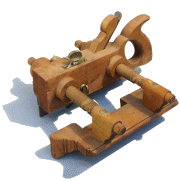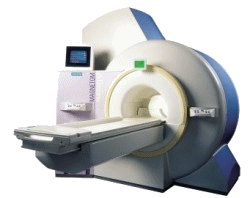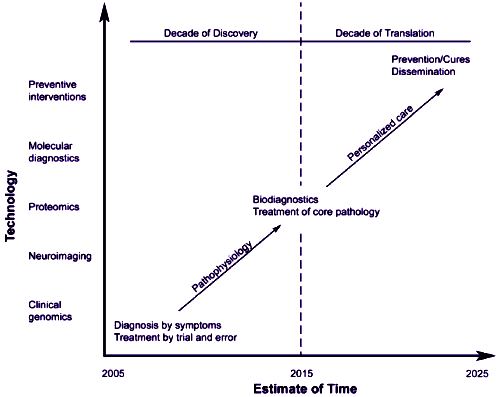by Thomas R. Insel, MD and Remi Quirion, Ph.D, FRSC, CQJAMA. 2005 294: 2221–2224.In this commentary, we argue that psychiatry’s impact on public health will require that mental disorders be understood and treated as brain disorders.
One of the fundamental insights emerging from contemporary neuroscience is that mental illnesses are brain disorders. In contrast to classic neurological illnesses that involve discrete brain lesions, mental disorders need to be addressed as disorders of distributed brain systems with symptoms forged by developmental and social experiences. While genomics will be important for revealing risk, and cellular neuroscience should provide targets for novel treatments for these disorders, it is most likely that the tools of systems neuroscience will yield the biomarkers needed to revolutionize psychiatric diagnosis and treatment. This essay considers the discoveries that will be necessary over the next two decades to translate the promise of modern neuroscience into strategies for prevention and cures of mental disorders. To deliver on this spectacular new potential, clinical neuroscience must be integrated into the discipline of psychiatry, thereby transforming current psychiatric training, tools, and practices.
 Two years ago [on this date oddly enough], I wrote a post about tools [tools…]. At the time, the topic was the misuse of statistical analysis. It was a couple of months after Robert Gibbons had published two articles claiming that antidepressants were both safe and effective in adolescents. I don’t believe that’s true based on experience. In fact, it was at a time when a teen had suicided in our community. I’d never met the boy, but I ended up seeing several of his friends, all of whom talked about his personality change after he started on that medicine [an SSRI]. This is not a place in the world where these kids would’ve read about that in our weekly paper. So I was particularly incensed at what I considered a misuse of the statistical tools of science to make a point that I thought is both wrong and dangerous.
Two years ago [on this date oddly enough], I wrote a post about tools [tools…]. At the time, the topic was the misuse of statistical analysis. It was a couple of months after Robert Gibbons had published two articles claiming that antidepressants were both safe and effective in adolescents. I don’t believe that’s true based on experience. In fact, it was at a time when a teen had suicided in our community. I’d never met the boy, but I ended up seeing several of his friends, all of whom talked about his personality change after he started on that medicine [an SSRI]. This is not a place in the world where these kids would’ve read about that in our weekly paper. So I was particularly incensed at what I considered a misuse of the statistical tools of science to make a point that I thought is both wrong and dangerous. But back then I was thinking, as I am now, about the ordinate labels on the figure above from Dr. Insel’s 2005 paper inaugurating his idea that psychiatry is, or should become, Clinical Neuroscience – genomics, neuroimaging, proteonomics, molecular diagnosis, the tools of a modern neuroscientist. I am personally a total sucker for tools. Of course I like them for what the can be used for, but it goes beyond that. I like them just for what they are. They distinguish us from other species. We don’t wait around for millennia to evolve structures to help us do new things. We make the new structures ourselves, and I’m still awed by that.
But back then I was thinking, as I am now, about the ordinate labels on the figure above from Dr. Insel’s 2005 paper inaugurating his idea that psychiatry is, or should become, Clinical Neuroscience – genomics, neuroimaging, proteonomics, molecular diagnosis, the tools of a modern neuroscientist. I am personally a total sucker for tools. Of course I like them for what the can be used for, but it goes beyond that. I like them just for what they are. They distinguish us from other species. We don’t wait around for millennia to evolve structures to help us do new things. We make the new structures ourselves, and I’m still awed by that.
 I first heard about those tools on the y-axis up there talked about in this way Insel is talking back in the early 1980s with the coming of a new chairman to our department. Back then, we said genetics instead of genomics, and the neuroimagers were more primitive, but the sentiment was the same. These tools were going to lead us to a new world in psychiatry. Back then I thought, as I do now, that there are some mental illnesses that were likely have a biological substrate, but certainly not all, and certainly not the ones I had come to study and learn to treat – so I exited.
I first heard about those tools on the y-axis up there talked about in this way Insel is talking back in the early 1980s with the coming of a new chairman to our department. Back then, we said genetics instead of genomics, and the neuroimagers were more primitive, but the sentiment was the same. These tools were going to lead us to a new world in psychiatry. Back then I thought, as I do now, that there are some mental illnesses that were likely have a biological substrate, but certainly not all, and certainly not the ones I had come to study and learn to treat – so I exited.
At the time, I thought psychiatry was having a love affair with a new technology, and I can understand that. It was something close to our first time to really take advantage of these ultra-modern tools of science. One could actually see a living brain – even watch it do things. Very exciting. But within a few short years, the fantasies and hypotheses generated by this technology blossomed and were joined by those associated with the new drugs, fueled by the neoKraepelinian Tenets arising from Robins and Guze – a story we all know too well. They seemed to never look back, and people began to talk as if all mental illness was biologically based. For a long time, they didn’t exactly say it, but various aspects of that idea were the only things they discussed [they = Key Opinion Leaders]. Around the time I retired [2003], the embryonal DSM-5 Task Forced published a book [2002] that did as much as said it [it = Mental Illness is Brain Disease]. And Tom Insel went to the NIMH from jobs in Atlanta where he had directed a primate lab [Yerkes] and a multi-university translational science program, publishing the article above in 2005. He sure said it. So what had been widely implied for twenty years became the official paradigm.
I first ran across Tom Insel’s 2005 article three years ago [personalized medicine: the concept…] trying to chase down all the hype about personalized medicine [April 2011]. I had never seen a graph with tools on one of the axes. But it wasn’t until a few months later [the extent of it…] when I read the 2005 A Research Agenda for the DSM-V that I caught up to the full meaning. They had placed their cards on the table. Based on the tools and what they thought they were going to find using them, they were openly declaring Mental Illness is Brain Disease. And I didn’t even realize that they had made this declaration until after they had already failed to deliver and had been forced to admit that failure publicly [Neuroscience, Clinical Evidence, and the Future of Psychiatric Classification in DSM-5, see class action in the air…]. Then, as we have heard for decades, they pushed the confirmation into the future. They hadn’t gotten there "yet".
 I still love tools. I spend a lot of time playing with one of the biggest ones of all – the Internet. I carry a modern tool with me whenever I venture forth from our cabin. Like everyone else, when I want to contact anyone I know in the world or find out about any topic, I expect to be able to do those things one way or another quickly – something I would never have imagined even as a younger adult. But tools are things we make to use, to explore, to communicate. They aren’t things that go on an axis of a graph. Findings go on graphs, things that tools help us discover or uncover. If you right-click on the images in this blog [leftovers from the tools… post two years ago] and then select View Image, you’ll see what I named these pictures even back then. I saved the images with a term used for objects that have outgrown their literal meaning, even their symbolic meanings, and have become magical objects in their own right – supernatural objects. These tools are misused that way by many who don’t even operate the actual tools of neuroscience themselves. They’re touted as pointers to conclusions not yet remotely reachable, conclusions that have only been dreamed.
I still love tools. I spend a lot of time playing with one of the biggest ones of all – the Internet. I carry a modern tool with me whenever I venture forth from our cabin. Like everyone else, when I want to contact anyone I know in the world or find out about any topic, I expect to be able to do those things one way or another quickly – something I would never have imagined even as a younger adult. But tools are things we make to use, to explore, to communicate. They aren’t things that go on an axis of a graph. Findings go on graphs, things that tools help us discover or uncover. If you right-click on the images in this blog [leftovers from the tools… post two years ago] and then select View Image, you’ll see what I named these pictures even back then. I saved the images with a term used for objects that have outgrown their literal meaning, even their symbolic meanings, and have become magical objects in their own right – supernatural objects. These tools are misused that way by many who don’t even operate the actual tools of neuroscience themselves. They’re touted as pointers to conclusions not yet remotely reachable, conclusions that have only been dreamed.
I just saw an interview on MSNBC that made my skin crawl. A man was talking about developing technology to reload memories for people with Alzheimer’s that was like a pacemaker for the brain. Interesting. Promising, perhaps. Then he talked about pills that “erase” traumatic memories. Creepy, really creepy. It would make people with PTSD “more productive”. Then he talked about programming robots to cuddle and care for people. Vulgar, very very vulgar. Then he talked about a pill to make people “smarter”.
I’ve always loved the cutting edge, and was never one to stand athwart history yelling “STOP!,” but Jesus, help us! Too much of the world of sciences is getting out of hand. They’re not making decisions that are representative of what people want, much less what we need, they are working for themselves and industry.
From the article “… psychiatry’s impact on public health will require that mental disorders be understood and treated as brain disorders.”
Odd how so many of my depressed and anxious patients can describe chronic stresses, such as a painful marriage, a job they hate but need, a threatening social environment, constant fear of not being able to make ends meet, children who are not doing well, parents who are fighting … . These stresses are clearly correlated with their “brain disease” and if the stresses are reduced then its amazing how much of their anxiety and depression disappear.
If the water supply is contaminated with a pathogen and people are getting diarrhea, we don’t claim that the public health solution requires us to understand their diarrhea as a gastrointestinal disorder. No. We clean up the water.
From a public health perspective, treating the “brain disease” without making any effort to acknowledge and ameliorate the social causes seems absurd.
I think it can be a problem thinking of the social and biological so separately, when as a typically group-dwelling animal the former has been built into the latter in many ways. Likewise human social processes have human biological substrates.
Tool use, and the cultural transmission of it, has been demonstrated in non-human species.
Just because you have a hammer, not everything becomes a nail.
Steve Lucas
It is about making money, folks, and like any other addiction, once the euphoria is experienced, it is about more and more. A flawed species we humans are, the DNA hasn’t figured out yet how to naturally select out the addiction biology yet, not that addiction alone is just biological in nature.
But, it does make one pause and reflect why some cultures are so intolerant of addiction. Gee, societies crumble from them, interesting…
Well, in 20 years or so, they may conclusively demonstrate pursuing “neural circuits” for mood disorders is a waste of time.
There’s a word for RDoC: vaporware.
This is perhaps a relevant story in the Daily Telegraph in the UK, from the 13 January 2014.
4th fastest supercomputer takes 40 mins. to model one second of 1% human brain activity http://t.co/Rfiebzfiri
@Steve Lucas
Yes, but the better you are with a hammer the more likely you are to see everything as a nail.
@Joseph Arpaia
A hammer can be used to drive a screw. However, it really does a number on the screw and whatever you are driving it into.*
*I don’t really know how appropriate my statement is to this conversation. However, what you wrote made me think of what we did as a kids…pretty much just to see what would happen between a hammer and a screw. I vaguely recall my father being not so happy.